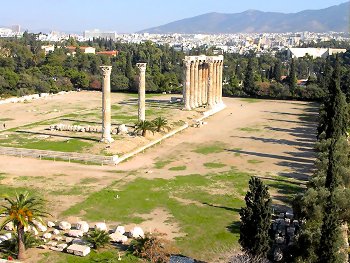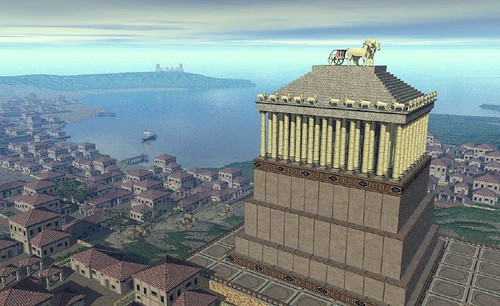 Location: At the city of Giza, a necropolis of ancient Memphis, and today part of Greater Cairo, Egypt.
Location: At the city of Giza, a necropolis of ancient Memphis, and today part of Greater Cairo, Egypt.Date of Construction: 2650-2500 BC
Builder: Egyptians
 Notable features: Built as the tomb of Fourth dynasty Egyptian pharaoh Khufu. When it was built, the Great pyramid was 145.75 m (481 ft) high. Over the years, it lost 10 m (30 ft) off its top. The structure consists of approximately 2 million blocks of stone, each weighing more than two tons.
Notable features: Built as the tomb of Fourth dynasty Egyptian pharaoh Khufu. When it was built, the Great pyramid was 145.75 m (481 ft) high. Over the years, it lost 10 m (30 ft) off its top. The structure consists of approximately 2 million blocks of stone, each weighing more than two tons.2. Hanging Gardens of Babylon
 Location: On the east bank of the River Euphrates, about 50 km south of Baghdad, Iraq.
Location: On the east bank of the River Euphrates, about 50 km south of Baghdad, Iraq.
Date of Construction: Around 600 BC
Builder: Babylonians
 Notable features: The building was about 75 feet high and the gardens were at different levels which complete with machinery for circulating water. Large trees grew on the roof. It is said that the Gardens were built by Nebuchadnezzar II to console his queen, Amytis of Media who missed the mountains, trees and flowers of her homeland.
Notable features: The building was about 75 feet high and the gardens were at different levels which complete with machinery for circulating water. Large trees grew on the roof. It is said that the Gardens were built by Nebuchadnezzar II to console his queen, Amytis of Media who missed the mountains, trees and flowers of her homeland. Date and cause of destruction: They were destroyed in an earthquake after the 1st century BC.
Date and cause of destruction: They were destroyed in an earthquake after the 1st century BC.3. Statue of Zeus at Olympia
 Location: At the ancient town of Olympia, on the west coast of modern
Location: At the ancient town of Olympia, on the west coast of modern Greece, about 150 km west of Athens.
Date of construction: Around 430 BC
Builder: Greeks Notable features: The seated statue occupied the whole width of the aisle of the temple that was built to house it, and was 40 feet (12 meters) tall. He was seated on a magnificent throne of cedar wood, inlaid with ivory, gold, ebony, and precious stones. In Zeus' right hand there was a small statue of Nike, the goddess of victory, and in his left hand, a shining scepter on which an eagle perched.
Notable features: The seated statue occupied the whole width of the aisle of the temple that was built to house it, and was 40 feet (12 meters) tall. He was seated on a magnificent throne of cedar wood, inlaid with ivory, gold, ebony, and precious stones. In Zeus' right hand there was a small statue of Nike, the goddess of victory, and in his left hand, a shining scepter on which an eagle perched. Date and cause of destruction: Olympia was further struck by earthquakes, landslides and floods, and the temple was damaged by fire in the fifth century AD. Earlier, the statue had been transported by wealthy Greeks to a palace in Constantinople. There, it survived until it was destroyed by a severe fire in AD 462.
Date and cause of destruction: Olympia was further struck by earthquakes, landslides and floods, and the temple was damaged by fire in the fifth century AD. Earlier, the statue had been transported by wealthy Greeks to a palace in Constantinople. There, it survived until it was destroyed by a severe fire in AD 462.
.
4. Temple of Artemis at Ephesus
. Location: The ancient city of Ephesus nears the modern town of Selcuk, about 50 km south of Izmir (Smyrna) in Turkey.
Location: The ancient city of Ephesus nears the modern town of Selcuk, about 50 km south of Izmir (Smyrna) in Turkey.
Date of construction: around 550 BC
Builder: Greeks Notable features: Dedicated to the Greek goddess Artemis, it took 120 years to build. The temple served as both a marketplace and a religious institution. The building was made of marble, with a decorated façade overlooking a spacious courtyard. Marble steps surrounding the building platform led to the high terrace which was approximately 80 m (260 ft) by 130 m (430 ft) in plan. The columns were 20 m (60 ft) high with Ionic capitals and carved circular sides. There were 127 columns in total, aligned orthogonally over the whole platform area, except for the central cellar or house of the goddess.
Notable features: Dedicated to the Greek goddess Artemis, it took 120 years to build. The temple served as both a marketplace and a religious institution. The building was made of marble, with a decorated façade overlooking a spacious courtyard. Marble steps surrounding the building platform led to the high terrace which was approximately 80 m (260 ft) by 130 m (430 ft) in plan. The columns were 20 m (60 ft) high with Ionic capitals and carved circular sides. There were 127 columns in total, aligned orthogonally over the whole platform area, except for the central cellar or house of the goddess. Date and cause of destruction: On the night of 21 July 356 BC, a man named Herostratus burned the temple to ground in an attempt to achieve lasting fame. Alexander the Great conquered Asia Minor, he offered to rebuild the destroyed temple, but the Temple was not restored until after his death in 323 BC. And when the temple was again destroyed by the Goths in AD 262, the Ephesians vowed to rebuild.
Date and cause of destruction: On the night of 21 July 356 BC, a man named Herostratus burned the temple to ground in an attempt to achieve lasting fame. Alexander the Great conquered Asia Minor, he offered to rebuild the destroyed temple, but the Temple was not restored until after his death in 323 BC. And when the temple was again destroyed by the Goths in AD 262, the Ephesians vowed to rebuild. Ephesus was later deserted, and attempts were recently made to rebuilt the temple, but only a few columns have been re-erected.
Ephesus was later deserted, and attempts were recently made to rebuilt the temple, but only a few columns have been re-erected.
5. Mausoleum of Maussollos at Halicarnassus Location: In the city of Bodrum (f.k.a. Halicarnassus) on the Aegean Sea, in south-west Turkey.
Location: In the city of Bodrum (f.k.a. Halicarnassus) on the Aegean Sea, in south-west Turkey.
Date of construction: The tomb was built between 353 and 350 BC at Halicarnassus (present Bodrum, Turkey) and completed around 350 BC, three years after Maussollos death, and one year after Artemisia's.
Builder: Persians, Greeks Notable features: Built as the tomb of the king Maussollos. It stood approximately 45 meters (135 feet) in height, and each of the four sides was adorned with sculptural relieves. The structure was rectangular in plan, with base dimensions of about 40 m (120 ft) by 30 m (100 ft). Overlying the foundation was a stepped podium which sides were decorated with statues. The colonnade supported a pyramid roof which was in turn decoratedwith statues. A statue of a chariot pulled by four horses adorned the top of the tomb.
Notable features: Built as the tomb of the king Maussollos. It stood approximately 45 meters (135 feet) in height, and each of the four sides was adorned with sculptural relieves. The structure was rectangular in plan, with base dimensions of about 40 m (120 ft) by 30 m (100 ft). Overlying the foundation was a stepped podium which sides were decorated with statues. The colonnade supported a pyramid roof which was in turn decoratedwith statues. A statue of a chariot pulled by four horses adorned the top of the tomb.
Date and cause of destruction: For 16 centuries, the Mausoleum remained in good condition until an earthquake caused some damage to the roof and colonnade. In 1494 the Knights of St John of Malta used the stones of the Mausoleum to built a massive crusader castle. By 1522, almost every block of the Mausoleum had been disassembled and used for construction. Today, the massive castle still stands in Bodrum. Some of the sculptures survived and are today on display at the British Museum in London. At the site of the Mausoleum itself, only the foundation remains of the once magnificent Wonder.
Today, the massive castle still stands in Bodrum. Some of the sculptures survived and are today on display at the British Museum in London. At the site of the Mausoleum itself, only the foundation remains of the once magnificent Wonder.
6. Colossus of Rhodes
 Location: At the entrance of the harbor of the Mediterranean island of Rhodes in Greece.
Location: At the entrance of the harbor of the Mediterranean island of Rhodes in Greece.
Date of construction: 292-280 BC
Builder: Greeks
Notable features: The Rhodians decided to build a giant statue of their sun god Helios to celebrate their victory over Antagonids who attempt to break the Rhodo-Egyptian alliance. It was roughly the same size as the Statue of Liberty in New York, although it stood on a lower platform. To build the statue, his workers cast the outer bronze skin parts. The base was made of white marble, and the feet and ankle of the statue were
first fixed. When the colossus was finished, it stood about 33 m (110 ft) high. And when it fell, "few people can make their arms meet round the thumb". Date and cause of destruction: The construction of the Colossus took 12 years and was finished in 282 BC. For years, the statue stood at the harbor entrance, until a strong earthquake hit Rhodes about 226 BC. The city was badly damaged, and the Colossus was broken at its weakest point -- the knee.
Date and cause of destruction: The construction of the Colossus took 12 years and was finished in 282 BC. For years, the statue stood at the harbor entrance, until a strong earthquake hit Rhodes about 226 BC. The city was badly damaged, and the Colossus was broken at its weakest point -- the knee.
For almost a millennium, the statue lay broken in ruins. In AD 654, the Arabs invaded Rhodes. They disassembled the remains of the broken Colossus and sold them to a Jew from Syria. It is said that the fragments had to be transported to Syria on the backs of 900 camels.Today statues of deer mark the two sides of the harbor.
7. Lighthouse of Alexandria
 Location: On the ancient island of Pharos, now a promontory within the city of Alexandria in Egypt.
Location: On the ancient island of Pharos, now a promontory within the city of Alexandria in Egypt.Date of construction: 3rd century BC
Builder: Hellenistic Egypt
Notable features: It was built BC as a monument around 290. It was dedicated to the Savior Gods. For centuries, the Lighthouse of Alexandria (occasionally referred to as the Pharos Lighthouse). The internal core was used as a shaft to lift the fuel needed for the
fire. At the top stage, the mirror reflected sunlight during the day while fire was used during the night.The mysterious mirror could reflect the light tens of kilometers away. Legend says the mirror was also used to detect and burn enemy ships before they could reach the shore. The total height of the building including the foundation base was about 117 m (384 ft).
 Date and cause of destruction: When the mirror was brought down mistakenly, they did not restore it back into place. In AD 956, an earthquake shook Alexandria, and caused little damage to the Lighthouse. It was later in 1303 and in 1323 that two stronger earthquakes left a significant impression on the structure. When the famous Arab traveler Ibn Battuta visited Alexandria in 1349, he could not enter the ruinous monument
Date and cause of destruction: When the mirror was brought down mistakenly, they did not restore it back into place. In AD 956, an earthquake shook Alexandria, and caused little damage to the Lighthouse. It was later in 1303 and in 1323 that two stronger earthquakes left a significant impression on the structure. When the famous Arab traveler Ibn Battuta visited Alexandria in 1349, he could not enter the ruinous monumentor even climb to its doorway.
 In AD 1480, the Egyptian Mamelouk Sultan, Qaitbay, decided to built a medieval fort on the same spot where the Lighthouse once stood, using the fallen stone and marble.
In AD 1480, the Egyptian Mamelouk Sultan, Qaitbay, decided to built a medieval fort on the same spot where the Lighthouse once stood, using the fallen stone and marble.
No comments:
Post a Comment